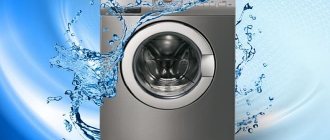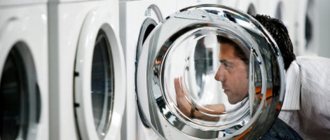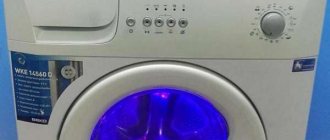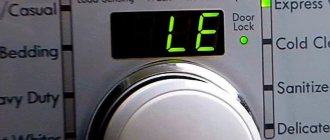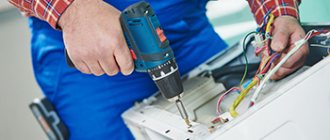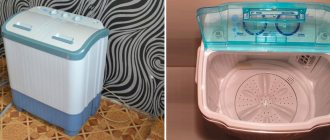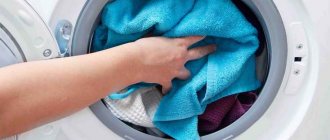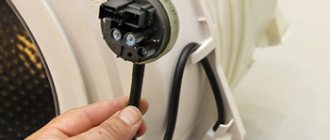Author of the article
Alexander Georgievich Kondratiev
An electrical engineer by training, he worked as an electronics engineer, chief engineer at a food company, and general director of a construction organization.
Many people are interested in how much water and electricity a washing machine consumes. The constant increase in tariffs forces us to use the machine less often. When purchasing a new washing machine, water and energy consumption are taken into account. We calculated how much resources she spends. The good news is that the numbers weren't particularly impressive.
What affects energy consumption
One of the indicators of economical operation is energy consumption. Electricity consumption is influenced by various factors:
- Power of the installed electric motor.
- Operating modes that provide optimal conditions for washing clothes.
- The amount of dirty raw materials deposited at a time.
- How dirty the laundry is loaded into the drum.
- Supply water temperature. The colder it is, the more electrical energy is required to heat it.
The energy consumption of the washing machine is indicated in the passport. During the washing process, the power varies from 300 W to 2 kW. Depends on the brand of the car and the selected mode. For one full cycle, electricity consumption ranges from 0.8 to 2 kW.
How much electricity is consumed to heat water depends on the heating elements installed in the unit. Thus, consumption is determined by the washing mode and engine power.
It should be taken into account that the passport contains data from laboratory tests, which differ significantly from the real ones. The discrepancy can be up to 20% upward.
Electricity consumption of household appliances: table and tips for saving
The annual increase in the cost of electrical energy forces users to think about methods of controlling its consumption and ways to save. The instructions for any equipment indicate the power of the device. However, this is an average value and may vary depending on certain factors. You can learn how to correctly calculate the electricity consumption of household appliances from this article.
The more appliances you use in your home, the higher your energy costs will be.
Energy class
The energy consumption class is indicated by letters of the Latin alphabet from A to G in kW/kg of laundry. The machines of the subgroup designated by the letter A have the lowest consumption.
In subgroups, “+” signs are used. The more there are, the more economical the unit is. The power consumption of the washing machine is shown in the table below.
| Energy class | Electricity consumption when washing 1 kg of dry laundry |
| A+++ | 0.11 kW/kg |
| A++ | 0.15 kW/kg |
| A+ | 0.17 kW/kg |
| A | 0.17-0.19 kW/kg |
| IN | 0.19-0.23 kW/kg |
| WITH | 0.23-0.27 kW/kg |
| D | 0.27-0.31 kW/kg |
| E | 0.31-0.35 kW/kg |
| F | 0.35-0.39 kW/kg |
| G | More than 0.39 kW/kg |
The industry has stopped producing equipment below class C as economically unprofitable. You can still find such models on sale, but few people buy them. In one cycle they “eat up” 1 kW or more.
"P" value
Power, which determines the rate of energy consumption, plays a key role. Washing machines show performance in the range of 2–4 kW. High numbers are due to the need to heat water and impose special requirements on connecting equipment. Due to restrictions regarding the current carried by the wires. The power of the washing machine is 2.2 kW, the current consumption is 10 A. The throughput of copper wires is 14 A/mm2, the parameter for aluminum wiring is 10 A/mm2. The device, which consumes 2.2 kW, is connected after first calculating the cross-section of the wires.
If P equipment exceeds the cable transmittance, you will need to convert the indicator into amperes using the formula: N (kW) × 4.35 = A. Empirically it looks like this: 4 kW × 4.35 = 17.5 A. Divide the result by the number of square millimeters, stated above. Compare the necessary information. We conclude: connecting a machine with power
, is performed using aluminum wire with a core cross-section of 2 mm2 or copper wire with a cross-section of 1.5 mm2.
How much electricity does a washing machine consume?
Electricity consumption depends on the model, energy consumption class, and selected mode. To calculate, you need to multiply the data from your passport by the tariff in force in the city of residence.
But the data will be incomplete. It is necessary to take into account the number of washes per month. On the Internet you can find information that consumption depends on the design of the machine. This is partly true. But automatic washing machines with the same parameters, front-loading or horizontally loading, consume the same amount of electricity.
Electricity consumption will depend on the selected program and the set water temperature.
Let's take a modern popular model as an example, the Whirlpool FWSD 81283 WCV washing machine:
- Consumption class A+++ with a consumption of 0.11 kW/kg;
- Full load is 8 kg;
- We determine the consumption for one cycle 0.11*8=0.88 kW;
- We take the tariff of the city, for example, in Kursk it is 4.03. We multiply the obtained data by the tariff in kW 0.88 * 4.03 = 3.55 rubles.
We got the approximate electricity consumption for one wash. The average family does laundry 10 times a month. The resulting value is 3.55 rubles. Multiply by 10, we get 35.5 rubles. per month.
But this is a calculated value. It must be adjusted to obtain real values, that is, increased by approximately 15%. We get an approximate consumption of a washing machine per month of 41 rubles.
Often, measuring instruments are installed to accurately determine energy consumption. Perform a washing cycle with maximum load, monitoring the entire process using instruments.
The unit consumes different amounts of electricity in different operating modes. For example, when heating water and simultaneously slowly turning the drum, maximum power consumption occurs.
When draining the water it is minimal. The average value is taken for calculation. To obtain accurate data, connect an electric meter to the washing machine and record the initial readings. After the end of the cycle, the result is obtained, which is multiplied by the tariff.
How to reduce energy consumption of household appliances
To reduce the electrical energy consumption of household appliances, there are several effective techniques. A good result is achieved by using an energy-saving refrigerator that can operate in this mode all year round, regardless of weather conditions.
It is better to organize the lighting system in the house using modern LED or energy-saving lamps. Their installation will not only save energy, they are also characterized by a longer operating period. A good effect is achieved by installing local lighting in the kitchen, bedroom, hallway, and living room, which also saves energy.
Note! The use of extension cords and adapters increases power consumption.
Refrigerators and freezers should be defrosted promptly. The presence of excess ice on the internal walls of devices increases energy consumption.
Tips for saving energy consumption.
While the computer is running, you can select the optimal power consumption mode for it. It will automatically turn off when left idle for a certain period of time. When exiting sleep mode, much less energy will be needed compared to normal switching on.
On a note! It will be possible to reduce energy costs by installing a multi-tariff meter, the night and day readings of which are calculated at different tariffs. At night the cost of electricity is lower.
When operating heating devices, you can use heat-reflecting screens, which help increase heat transfer and reduce energy consumption.
When choosing household appliances, you should consider how many watts (kilowatts) the appliance consumes per hour. It is better to give preference to economical devices that will meet the stated requirements, while saving the energy resources necessary for their operation.
What affects water consumption
The efficiency of the unit is not limited to electricity consumption. In order to wash clothes, you will need cold water. According to statistics, a family of three spends up to 25% of their total monthly water consumption on laundry. And this is a significant amount of utility bills.
We will not consider rotary-type cars that our grandmothers and mothers bought. A modern washing machine consumes from 35 to 85 liters in one full cycle.
These are averaged data obtained empirically in the laboratory of the manufacturer. However, the real numbers are higher.
The following factors influence water consumption:
- Drum volume. The larger it is, the more liquid is required for washing.
- Contamination of raw materials. Dirty bedding takes longer to wash and rinse.
- Selected mode. An incorrectly selected mode increases water consumption.
- Incomplete loading of the drum is economically unprofitable. You have to run the washer several times to wash what can be washed at once.
There is a misconception that liquid consumption depends on water heating. However, heating does not affect water consumption.
How much water does the washing machine consume?
For the consumer, this indicator is significant. Since approximately a quarter of the monthly volume of water is spent on washing clothes. The water consumption of the washing machine is indicated in the passport. These indicators have an average value obtained as a result of laboratory experiments by the manufacturer.
Real data may differ significantly from passport data, which depends on:
- Type of car. Modern computer-controlled machines consume less resource per cycle.
- The volume of the drum determines the amount of liquid used. For example, a unit with a capacity of 7 kg of dry laundry consumes 80 liters; for 9 kg it already consumes 126 liters. Popular washing machine with a 4-5 kg drum. has an average water consumption of only 39-42 liters;
- Laundry is dirty and the drum is full.
However, the consumer is interested in knowing how much water his machine actually consumes per wash. To independently determine the flow rate, proceed as follows:
- Record the cold water meter readings;
- Start the machine with maximum load, setting the program corresponding to the loaded raw materials;
- During this period, it is prohibited to use the toilet, open taps in the bathroom and kitchen;
- After the wash is finished, the readings are read and how many liters of water are actually consumed in one cycle.
Compare the passport readings with the result obtained. If the discrepancy is 10-20 liters per wash, this is considered normal.
Real data exceeding the passport data by more than 1.5 times indicates a malfunction. You should look for the cause of excess fluid consumption. Check seals and integrity of hoses.
Let's present an example of flow calculation for Whirlpool FWSD 81283 WCV:
- The passport consumption per wash is 47 liters;
- We take the tariff, for example, for the city of Kursk it is 22.04 per 1 m3;
- We assume 10 washes per month;
- We get a monthly consumption of 47*10=470 liters per month;
- Considering that the actual consumption exceeds the calculated one by 10-20 liters, we take the average value of 15 liters. 15*10=150;
- We add the resulting values 470+150=620. We find that the washing machine consumes 0.62 m3 of water per month;
- We multiply the resulting value by the tariff 0.62 m3 * 22.04 = 13.66 rubles. per month.
The actual payment for water for 10 washes per month is 13 rubles 66 kopecks.
Economy modes and programs
Choosing a program is one area where you can save money. In this case, two components are taken into account - electricity and water.
Using the half-hour mode allows you to save money. You should not use “delayed start”; when not in operation, the unit consumes electricity.
Let's consider how much water is needed for a half-hour cycle:
- Fast mode consumes 50 liters at 30 0C;
- 40 degrees when washing cotton will require 72 liters;
- Eco mode at 60 degrees will require 45 liters of water when washing.
Electricity consumption is affected by the choice of washing mode.
Consider half-hour cycles:
- Washing cotton at 30 0C will require 0.8 kW;
- Cotton at 40 0C consumes 0.85 kW;
- “Eco” at 60 0C will need 1.45 kW.
Having compared the costs, we conclude that the most economical washing mode occurs in a half-hour mode at 30 degrees.
